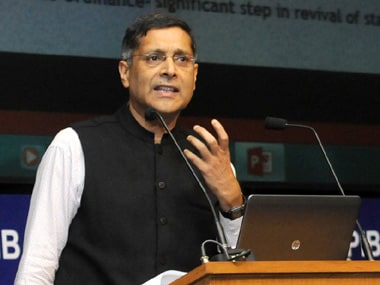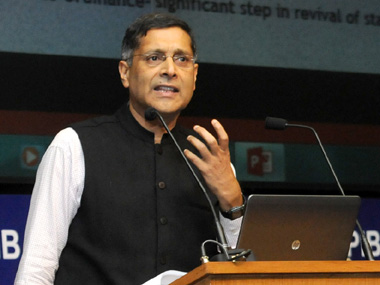Seetha Soon after chief economic adviser Arvind Subramaniam presented the mid-year review of the economy, finance minister Arun Jaitley was at a meeting of the parliamentary consultative committee on finance. He was quick to give credit for the relatively good performance of the economy to government policy and structural reforms. The review does peg growth this fiscal down to the 7-7.5 percent range, down from the 8.1-8.5 percent predicted in the Economic Survey in February, but India still remains among the fastest growing economies. Besides, Subramaniam explained that lowering of growth estimate was due to some wild cards that appeared, among them the continued slump in global demand affecting exports and the googly thrown by the weather gods. [caption id=“attachment_2399194” align=“alignleft” width=“380”]
 Chief economic advisor Arvind Subramanian. Image courtesy PIB[/caption] It is true, as the review points out, that the economy has held on its own in the face of stiff challenges and this government has been active on the economic policy front, but are those actions translating into growth? A paper by HSBC Global Research earlier this week had noted that economic recovery is patchy (something the review acknowledges by talking about mixed signals) and that only 50 percent of the economy is improving. And even in this 50 percent, 35 percentage points is due to softer oil prices, only 15 percentage points is due to government action. This is not to knock what the government is doing but only to point to the significant challenges that remain. But let’s look at the positives - there’s steady recovery in economic growth, inflation has moderated, the twin deficits (fiscal deficit and current account deficit) are manageable, tax collections are buoyant, capital expenditure is taking up a larger share of the spending pie than revenue expenditure. The growth drivers, the review document says, are private consumption (referred to as the unambiguously bright spot in the economy) and public investment. These are not empty claims; anyone tracking economic data can vouch for these. The report seeks to allay the concerns over continued fall in exports – latest data shows that export decline continued for 12 straight months – which has led to a one percentage point drag on growth. The bright side of the export picture, the review says, is that India has not lost significant global market share in either commodity exports or services exports. But what of the future? The review’s optimism about growth picking up in the second half may hold good, but 2016-17 appears to be more of a worry, with the review estimating that real GDP growth next year may not be very much higher. There are some imponderables as of now. One, how will oil prices move? If they start hardening, as there appear to be initial signs, then the private consumption demand that buoyed growth this year may be subdued. Two, related to this, the implementation of the Seventh Pay Commission recommendations and the one rank one pension could give some demand boost but they could also put a strain on public finances (the pay commission alone could mean additional expenditure of 0.65 percent of GDP) and pose a challenge to deficit reduction targets. The stress on keeping to these fiscal targets could detract from demand, as the review notes. What the government needs to do, the review says, is a mix of demand management and strengthening of the supply side. “There can be no relenting in the pace and direction of supply-side reforms whose benefits are, and will be, unambiguous in direction and substantial in magnitude, even if not necessarily early in impact.” But the mid year review is an economic document, which steers clear of politics. It is now amply clear that no big bang reform that requires legislative action is going to be possible as long as the Congress continues to have a majority in the Rajya Sabha. So the goods and services tax (GST) and the bankruptcy law reform that the review makes a strong pitch for are unlikely to happen. What the government needs to do is to start identifying all that is possible without having to go to Parliament. In this
article
, C. Rangarajan and M. Govind Rao have argued that the central government can make a start on GST by reforming its own indirect taxes at the manufacturing stage. Similarly, options to introduce a bankruptcy code without resorting to legislation should be explored. Two months into the next financial year, the Narendra Modi government will enter its third year in office. Time is running out for it. Political management with the objective of better economic management has to be its key focus. There is no getting away from that.
Chief economic advisor Arvind Subramanian. Image courtesy PIB[/caption] It is true, as the review points out, that the economy has held on its own in the face of stiff challenges and this government has been active on the economic policy front, but are those actions translating into growth? A paper by HSBC Global Research earlier this week had noted that economic recovery is patchy (something the review acknowledges by talking about mixed signals) and that only 50 percent of the economy is improving. And even in this 50 percent, 35 percentage points is due to softer oil prices, only 15 percentage points is due to government action. This is not to knock what the government is doing but only to point to the significant challenges that remain. But let’s look at the positives - there’s steady recovery in economic growth, inflation has moderated, the twin deficits (fiscal deficit and current account deficit) are manageable, tax collections are buoyant, capital expenditure is taking up a larger share of the spending pie than revenue expenditure. The growth drivers, the review document says, are private consumption (referred to as the unambiguously bright spot in the economy) and public investment. These are not empty claims; anyone tracking economic data can vouch for these. The report seeks to allay the concerns over continued fall in exports – latest data shows that export decline continued for 12 straight months – which has led to a one percentage point drag on growth. The bright side of the export picture, the review says, is that India has not lost significant global market share in either commodity exports or services exports. But what of the future? The review’s optimism about growth picking up in the second half may hold good, but 2016-17 appears to be more of a worry, with the review estimating that real GDP growth next year may not be very much higher. There are some imponderables as of now. One, how will oil prices move? If they start hardening, as there appear to be initial signs, then the private consumption demand that buoyed growth this year may be subdued. Two, related to this, the implementation of the Seventh Pay Commission recommendations and the one rank one pension could give some demand boost but they could also put a strain on public finances (the pay commission alone could mean additional expenditure of 0.65 percent of GDP) and pose a challenge to deficit reduction targets. The stress on keeping to these fiscal targets could detract from demand, as the review notes. What the government needs to do, the review says, is a mix of demand management and strengthening of the supply side. “There can be no relenting in the pace and direction of supply-side reforms whose benefits are, and will be, unambiguous in direction and substantial in magnitude, even if not necessarily early in impact.” But the mid year review is an economic document, which steers clear of politics. It is now amply clear that no big bang reform that requires legislative action is going to be possible as long as the Congress continues to have a majority in the Rajya Sabha. So the goods and services tax (GST) and the bankruptcy law reform that the review makes a strong pitch for are unlikely to happen. What the government needs to do is to start identifying all that is possible without having to go to Parliament. In this
article
, C. Rangarajan and M. Govind Rao have argued that the central government can make a start on GST by reforming its own indirect taxes at the manufacturing stage. Similarly, options to introduce a bankruptcy code without resorting to legislation should be explored. Two months into the next financial year, the Narendra Modi government will enter its third year in office. Time is running out for it. Political management with the objective of better economic management has to be its key focus. There is no getting away from that.
Mid-year review: Time running out for Modi-government to act on the reforms front
FP Archives
• December 19, 2015, 14:30:52 IST
The review does peg growth this fiscal down to the 7-7.5 percent range, down from the 8.1-8.5 percent
Advertisement
)